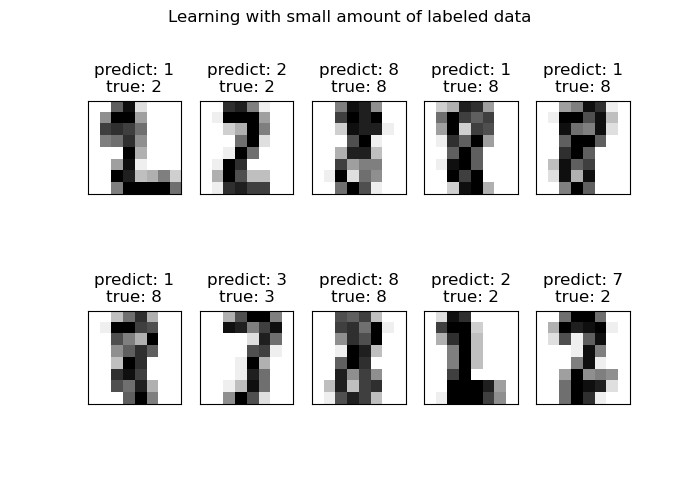Nota
Haz clic aquí para descargar el código completo del ejemplo o para ejecutar este ejemplo en tu navegador a través de Binder
Dígitos de Propagación de Etiquetas: Demostración del rendimiento¶
Este ejemplo demuestra la potencia del aprendizaje semisupervisado al entrenar un modelo de Propagación de Etiquetas (Label Spreading model) para clasificar dígitos escritos a mano con conjuntos de muy pocas etiquetas.
El conjunto de datos de dígitos escritos a mano tiene 1797 puntos en total. El modelo se entrenará utilizando todos los puntos, pero sólo se etiquetarán 30. Los resultados en forma de una matriz de confusión y una serie de métricas sobre cada clase serán muy buenos.
Al final, se mostrarán las 10 predicciones más inciertas.

Out:
Label Spreading model: 40 labeled & 300 unlabeled points (340 total)
precision recall f1-score support
0 1.00 1.00 1.00 27
1 0.82 1.00 0.90 37
2 1.00 0.86 0.92 28
3 1.00 0.80 0.89 35
4 0.92 1.00 0.96 24
5 0.74 0.94 0.83 34
6 0.89 0.96 0.92 25
7 0.94 0.89 0.91 35
8 1.00 0.68 0.81 31
9 0.81 0.88 0.84 24
accuracy 0.90 300
macro avg 0.91 0.90 0.90 300
weighted avg 0.91 0.90 0.90 300
Confusion matrix
[[27 0 0 0 0 0 0 0 0 0]
[ 0 37 0 0 0 0 0 0 0 0]
[ 0 1 24 0 0 0 2 1 0 0]
[ 0 0 0 28 0 5 0 1 0 1]
[ 0 0 0 0 24 0 0 0 0 0]
[ 0 0 0 0 0 32 0 0 0 2]
[ 0 0 0 0 0 1 24 0 0 0]
[ 0 0 0 0 1 3 0 31 0 0]
[ 0 7 0 0 0 0 1 0 21 2]
[ 0 0 0 0 1 2 0 0 0 21]]
print(__doc__)
# Authors: Clay Woolam <clay@woolam.org>
# License: BSD
import numpy as np
import matplotlib.pyplot as plt
from scipy import stats
from sklearn import datasets
from sklearn.semi_supervised import LabelSpreading
from sklearn.metrics import confusion_matrix, classification_report
digits = datasets.load_digits()
rng = np.random.RandomState(2)
indices = np.arange(len(digits.data))
rng.shuffle(indices)
X = digits.data[indices[:340]]
y = digits.target[indices[:340]]
images = digits.images[indices[:340]]
n_total_samples = len(y)
n_labeled_points = 40
indices = np.arange(n_total_samples)
unlabeled_set = indices[n_labeled_points:]
# #############################################################################
# Shuffle everything around
y_train = np.copy(y)
y_train[unlabeled_set] = -1
# #############################################################################
# Learn with LabelSpreading
lp_model = LabelSpreading(gamma=.25, max_iter=20)
lp_model.fit(X, y_train)
predicted_labels = lp_model.transduction_[unlabeled_set]
true_labels = y[unlabeled_set]
cm = confusion_matrix(true_labels, predicted_labels, labels=lp_model.classes_)
print("Label Spreading model: %d labeled & %d unlabeled points (%d total)" %
(n_labeled_points, n_total_samples - n_labeled_points, n_total_samples))
print(classification_report(true_labels, predicted_labels))
print("Confusion matrix")
print(cm)
# #############################################################################
# Calculate uncertainty values for each transduced distribution
pred_entropies = stats.distributions.entropy(lp_model.label_distributions_.T)
# #############################################################################
# Pick the top 10 most uncertain labels
uncertainty_index = np.argsort(pred_entropies)[-10:]
# #############################################################################
# Plot
f = plt.figure(figsize=(7, 5))
for index, image_index in enumerate(uncertainty_index):
image = images[image_index]
sub = f.add_subplot(2, 5, index + 1)
sub.imshow(image, cmap=plt.cm.gray_r)
plt.xticks([])
plt.yticks([])
sub.set_title('predict: %i\ntrue: %i' % (
lp_model.transduction_[image_index], y[image_index]))
f.suptitle('Learning with small amount of labeled data')
plt.show()
Tiempo total de ejecución del script: (0 minutos 0.350 segundos)
